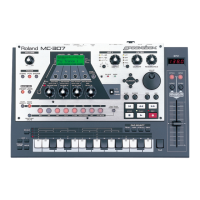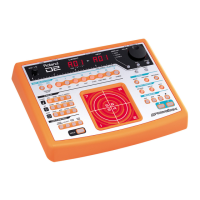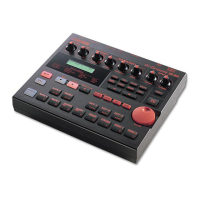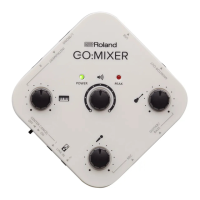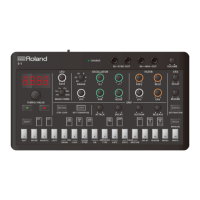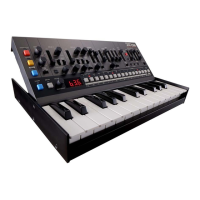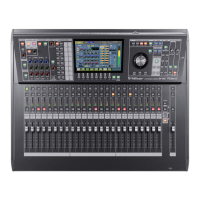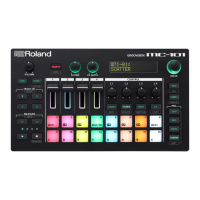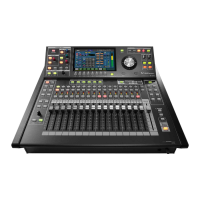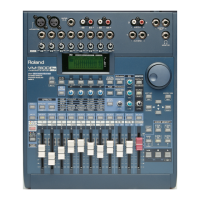80
Parameter List
Total Eect Parameters
COMP
Parameter Value Explanation
Switch OFF, ON
Species whether the master COMP (a
compressor applied to the entire sound
generator of the MC-707) is used (ON) or not
used (OFF).
Low Attack Time 0.1–100 [ms]
Species the time from when the input
exceeds Low Thres until compression is
applied to the volume of the low-frequency
band.
Low Release Time 10–1000 [ms]
In a state when compression is already being
applied, this species the time from when the
input decreases below Low Thres until the
low-frequency band stops being compressed.
Low Threshold -60–0 [dB]
Species the volume level at which
compression starts for the low-frequency
band.
Low Ratio
1: 1, 2: 1, 3: 1, 4: 1, 8: 1,
16: 1, 32: 1, INF: 1
Species the compression ratio for the low-
frequency band.
Low Knee 0–30 [dB]
This is a function that smooths the onset of
compression from the uncompressed state; it
gradually applies compression starting earlier
than Low Thres. Higher values produce a
smoother transition.
Low Output Gain -24.0–+24.0 [dB]
Species the output volume of the low-
frequency band.
Mid Attack Time 0.1–100 [ms]
Species the time from when the input
exceeds Mid Thres until compression is
applied to the volume of the mid-frequency
band.
Mid Release Time 10–1000 [ms]
In a state when compression is already being
applied, this species the time from when
the input decreases below Mid Thres until the
mid-frequency band stops being compressed.
Mid Threshold -60–0 [dB]
Species the volume level at which
compression starts for the mid-frequency
band.
Mid Ratio
1: 1, 2: 1, 3: 1, 4: 1, 8: 1,
16: 1, 32: 1, INF: 1
Species the compression ratio for the mid-
frequency band.
Mid Knee 0–30 [dB]
This is a function that smooths the onset of
compression from the uncompressed state; it
gradually applies compression starting earlier
than Mid Thres. Higher values produce a
smoother transition.
Mid Output Gain -24.0–+24.0 [dB]
Species the output volume of the mid-
frequency band.
HighAttack Time 0.1–100 [ms]
Species the time from when the input
exceeds High Thres until compression is
applied to the volume of the high-frequency
band.
High Release Time 10–1000 [ms]
In a state when compression is already
being applied, this species the time from
when the input decreases below High Thres
until the high-frequency band stops being
compressed.
High Threshold -60–0 [dB]
Species the volume level at which
compression starts for the high-frequency
band.
High Ratio
1: 1, 2: 1, 3: 1, 4: 1, 8: 1,
16: 1, 32: 1, INF: 1
Species the compression ratio for the high-
frequency band.
High Knee 0–30 [dB]
This is a function that smooths the onset of
compression from the uncompressed state; it
gradually applies compression starting earlier
than High Thres. Higher values produce a
smoother transition.
High Output Gain -24.0–+24.0 [dB]
Species the output volume of the high-
frequency band.
Split Freq Low
16–16000 [Hz]
Species the frequency at which the low-
frequency band (LOW) and mid-frequency
band (MID) are divided.
Split Freq Hi
Species the frequency at which the high-
frequency band (HIGH) and mid-frequency
band (MID) are divided.
EQ
Parameter Value Explanation
Switch OFF, ON
Species whether the master EQ (an equalizer
applied to the entire sound generator of the
MC-707) is used (ON) or not used (OFF).
EQ Input Gain -24–+24 [dB]
Adjusts the amount of boost/cut for the input
to the EQ.
Low Gain -24–+24 [dB] Gain of the low frequency range.
Low Freq 20–16000 [Hz] Frequency of the low range.
Mid1 Gain -24–+24 [dB] Gain of the middle frequency range 1.
Mid1Freq 20–16000 [Hz] Frequency of the middle range 1.
Mid1 Q 0.5–16.0
Width of the middle frequency range 1.Set a
higher value for Q to narrow the range to be
aected.
Mid2 Gain -24–+24 [dB] Gain of the middle frequency range 2.
Mid2Freq 20–16000 [Hz] Frequency of the middle range 2.
Mid2 Q 0.5–16.0
Width of the middle frequency range 2.Set a
higher value for Q to narrow the range to be
aected.
Mid3 Gain -24–+24 [dB] Gain of the middle frequency range 3.
Mid3 Freq 20–16000 [Hz] Frequency of the middle range 3.
Mid3 Q 0.5–16.0
Width of the middle frequency range 3.Set a
higher value for Q to narrow the range to be
aected.
High Gain -24–+24 [dB] Gain of the high frequency range.
HighFreq 20–16000 [Hz] Frequency of the high range.
MFX
Parameter Value Explanation
Switch OFF, ON Turns the eect on/o.
MFX parameters (Shows the parameters of the selected MFX.)
Cho Send
(Chorus Send Level)
0–127
Species the chorus send level of the sound
after MFX is applied.
Rev Send
(Reverb Send Level)
0–127
Species the reverb send level of the sound
after MFX is applied.
MFX CTRL
Src1–4
(MFX CtrlSrc 1–4)
Species the MIDI message that will control the corresponding MFX
CONTROL parameter.
OFF MFX will not be used.
MOD: CC01–31 Controller number 1–31
CC33–PHASR: CC95 Controller number 33–95
BEND Pitch Bend
AFT Aftertouch
SYS-CTRL1–SYS-
CTRL4
The controllers assigned by the system
parameters SysCtrlSrc1–4 Source are used.
MFX CTRL
Dst1–4
(MFX CtrlDst 1–4)
Species which of the multi-eect parameters are controlled using
MFX CONTROL. The multi-eects parameters available for control
will depend on the multi-eects type.
MFX CTRL
Sens1–4
(MFX CtrlSens 1–4)
-63–+63
Species the depth of MFX CONTROL.
Specify a positive “+” value if you want to
change the value of the assigned destination
in a positive direction (larger, toward the
right, faster, etc.), or specify a negative value
“-” if you want to change the value in a
negative direction (smaller, toward the left,
slower, etc.). Larger values will allow a greater
amount of control.
Controlling a MFX via MIDI
(MFX CONTROL)
You can use MIDI messages such as control change messages to control the principal MFX
parameters. This capability is called “MFX CONTROL (multi-eects control).”
The editable parameters are pre-determined according to the MFX type. You can specify up
to four parameters for multi-eect control.
To use MFX CONTROL, you’ll need to specify which MIDI message (Source) will aect which
parameter (Destination), and how greatly (Sens).
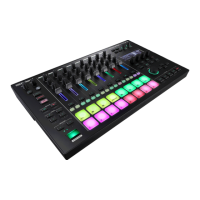
